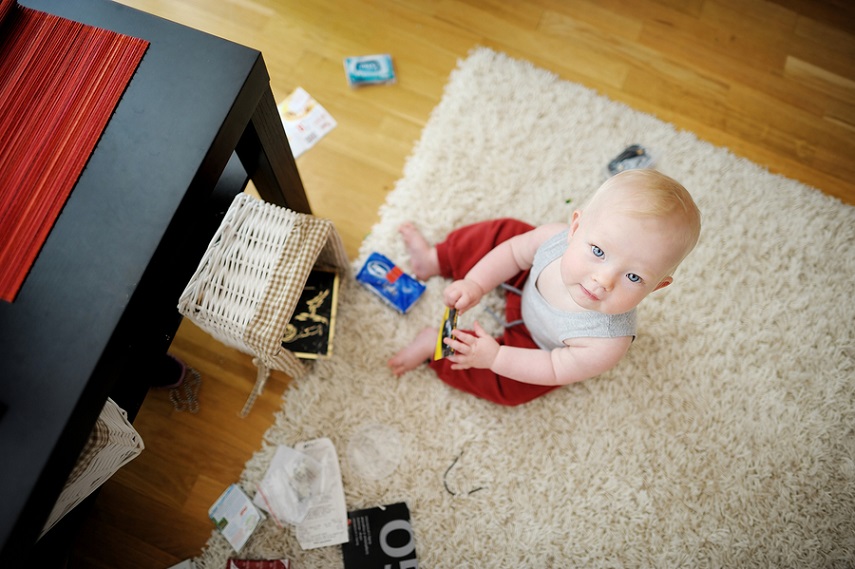Just about everyone has a particular vision of the perfect home and often they also have it all mapped out – down to the last detail! Where should it be located, how the garden should look, and exactly how the interior should be designed – it is no secret that homeowners take immense pride in constructing a safe haven for their families. Not only does the house construction in Pakistan need to be aesthetically pleasing, savvy homeowners expect each and every part of the house to serve a dedicated function for residents. Modern house designs in Pakistan now consist of family-friendly modifications that offer convenience for multi-generational households. Whether a homeowner is anticipating the addition of a new baby, an elderly parent or a family member with limited mobility, their needs can be easily met with a home renovation project.
How “Baby-Proof” is Your Home?

In order to baby-proof your home, you have to make sure that anything within your child’s reach, that can be perceived as a toy or can be easily damaged, is kid-friendly. Other steps you can take to baby-proof your house includes:
- Repaint the walls that still have older lead-based paint on them. There is a real danger of young children nibbling on toxic paint chips as they crawl around the home.
- Swap out glass mirrors for safer, shatterproof acrylic alternatives.
- Replace the carpeting with hardwood floors. Hardwood floors are easy to clean and unlike carpeting, do not trap allergy-causing irritants like mites, dust and pet dander.
- Cover your fireplace with panels that completely block out access to the hearth. You can also get the fireplace panels painted with a faux log-burning scene that looks great and keeps your children safe.
- Check side tables and coffee tables for their sturdiness and weight-bearing ability. Light tables can topple over when a crawling infant grabs on for support. Another table-related kid-proofing tip is to use soft rubber corner protectors in all the rooms.
- Regularly check the baby’s crib for age-appropriate railing height and other similar safety settings.
Basically, you will have to remove, replace or alter any piece of furniture or electronic appliance that an infant or toddler can potentially topple, break, stain or use as a toy. Instead, make your child’s safety a priority and transform your home into a kid-friendly space.
Don’t Forget the Elderly

Caring for one or both of one’s parents requires a combination of empathy, compassion, and patience, especially when they have to leave their own behind. Work with an architect that recognizes the unique challenges of modifying one’s home when an elderly parent moves in. One key adjustment homeowners have to make while moving a parent is to reassess the lighting. There should be adequate lighting and backup lighting arrangements in case of an extended power outage or maintenance. One’s vision progressively weakens with age, so it is important to install emergency lights in bathrooms, corridors as well as in the parent’s bedroom.
Next up is the bathroom, where slippery tiles pose a serious risk to the elderly. Install non-slip grab bars around the perimeter of the bathroom, affix non-slip rubber mats in the shower stall and set-up plastic safety benches for the bathtub area. Elderly mobility experts suggest fitting raised toilet seats for added comfort. Bathroom doorways can also be widened to better accommodate wheelchairs and walkers. In addition to these safety measures, it is highly recommended to set up ‘panic buttons’ in the bedroom and bathroom in case of an emergency. Test out the buzzers as they should be clearly audible all over the house. The idea is to make your aging parent’s transition to their new home as comfortable and pleasant as possible.
Individuals with Limited Mobility

The first hurdle to eliminate for family members with limited mobility is to design a no-step entrance. With the addition of a ramp with a gradual incline, no-step entrances work well for anyone with knee problems, walkers, wheelchairs or even a crutch. When hiring a construction company in Lahore, make sure that you convey this requirement to them in the design phase. After sorting out the entrance, remove any potential tripping hazards in the form of sprawling rugs, crisscrossing extension cords and uneven flooring. Moving into the kitchen, it makes sense to adjust the counter and cabinet heights so they remain accessible for wheelchair users. Low work surfaces, which include custom-made islands and kitchen sink counters, are also kid-friendly. Taking a page out of the ‘smart homes’ book, homeowners are now setting up the lighting, air conditioners, gates, locks and even heating devices for remote control use. Family members, with either temporary or permanent mobility issues, can readily operate appliances and utilities through their smartphone or laptop.
In fact, a smart security system allows residents to screen guests and monitor entrances and exits through automated gates without moving an inch. A number of home modifications recommended for the elderly can also be adapted for individuals with limited mobility. As modern house designs in Pakistan continue to evolve, your next home renovation project can easily balance a contemporary design with all the comfort, safety and accessibility measures required by your family.